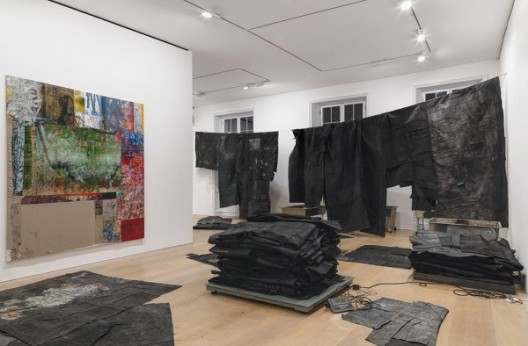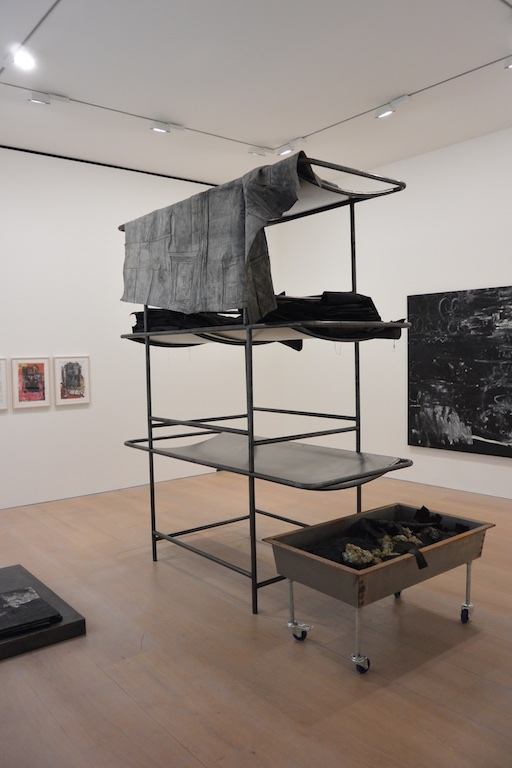Simon Lee Gallery (12 Berkeley Street, London W1J 8DT) Oct 13 – Nov 14, 2015
Oscar Murillo: binary function
David Zwirner (24 Grafton Street, London W1S 4EZ) Oct 10 – Nov 20, 2015
John Hoyland: Power Station Paintings. 1964-1982
Newport Street Gallery (Newport Street, London, SE11 6AJ) Oct 8, 2015 – Apr 3, 2016
Lee Ufan: From Point, From Line, From Wind
Pace (6 Burlington Gardens, London W1S 3ET) Sep 15 – Oct 31, 2015
Four recent shows in London remind us why “abstract” painting remains compelling for understanding what painting is. Each show eschewed the decorative “tail-feather” displays of what is now commonly known as “zombie abstraction.” The shows were about what it is to paint—physically, formally, and conceptually.

At Simon Lee Gallery, Heimo Zobernig’s new paintings, each 2 x 2 m square, were smattered with radioactively fluorescent post-it note sized squares of green and pink, and others of blue and grey, over gestural layers of Chroma-key daylight colors. The mosaic-effect, drawn from the low-resolution pixilation’s of early 1980s video screens, was like an electric surge that leaves you overwhelmed and bewildered. Slowly, slowly emerged words: VIDEO, PAINTING, LOOK.
Since the late 1990s, Heimo Zoberig (b.1958, Austria) has used painting, film and sculpture to explore notions of modernism, in particular ideas about the screen and the grid. In this show, he has pushed further the concept of layers of paint as both concealing and revealing. In a sense, this recalls the infinite strokes of Willem de Kooning, whereby gestural marks sweep under and over each other, linking background and foreground and creating a visual/conceptual “space” within and between the strokes. But the words and the over-layers of squares in Zoberig’s work force us to unpack the meaning; in fact, the entire show is about how we do so.
Simon Lee Gallery is the most dedicated program gallery in London focused on contemporary painting. It would be easy but incorrect to say that the gallery concentrates on abstract painting: its exhibitions are precisely about painting and the artist’s struggle with its history and its formal, physical and conceptual dynamics. Zobernig, then, sits well with other artists in the gallery’s roster such as John Armleder, Matias Faldbakken and David Ostrowski, but also artists like George Condo and even Angela Bulloch. There is always an artistic-super-conscience at work. This is why, when visiting the gallery, the first question should not be “what is this?” but “why am I looking?”—because we come with the history of art inside us, and artists like Zobernig play to art history’s triggers.

At David Zwirner, Oscar Murillo’s (b. 1986, Columbia) show blended film, sound, installation, painting, and drawing. Canvases were hung like an operatic curtain in front of the window. Others, dyed inky black, were cast on the floor like rumpled studio drop sheets. Steel bunks recalled Anselm Kiefer. Like Zobernig, the paintings were layered with the process of painting, including mistakes, erasures, smudges and accidental dirt from the place of its making. It looks theatrical, too—a stage awaiting a performance. But again, this is about the reality of the work, which is to say, the created space of the exhibition and its individual elements but also the actual space it inhabits, in a room, in a building, in a city—where we live, and how. Here, the film of a New Year’s Day street party in the artist’s hometown, La Paila in Columbia, is crucial; it offers a point of contrast and therefore a key to how we can approach the other parts of the installation. Painting is also about communication—not only with an immediate audience but across geographical and linguistic space.

Newport Street Gallery is Damien Hirst’s recently launched art space dedicated to showing work from his collection. It is beautiful, but also practical—designed to show art rather than showcase its architect or owner. Hirst’s detractors may question this, but it is noteworthy that Hirst has been one of the most active advocates for and supporters of fellow artists—Sarah Lucas, Rachel Howard and Ashley Bickerton have all been vocal about their respect for and thanks to Hirst. An artist who was initially skeptical about Hirst was the British painter John Hoyland (1934-2011). However, at a time when the artist was largely overlooked, Hirst was a great fan of Hoyland’s giant abstract paintings. The two became close friends, and Hirst Hoyland’s foremost collector. SFor these reasons it is apt that a show of Hoyland’s works should inaugurate the Newport Street Gallery. And it is stunning. Descriptions can be read and JPGs poured-over, but the experience of being there—what every exhibition should strive for—changes one’s perception, and the memory of it remains long after leaving the show. Traditionally, English painting can be finicky and labored—times, even that of masters such as Bacon; the one real exception is Turner. Here, though, is an exhibition about color, freedom, and scale. The paintings and their painting work internally, the brush and movement of pigment about the defined space and surface of each work. But then each work itself is injected into the physical space of the viewer, into this reality. And it is the size that shakes you because we are no longer dealing with a specimen in a book or on a computer or hung on a lounge-room wall, but a physical giant that you are forced to confront. The show is on until April 2016. If you can, go.
Finally, at Pace Gallery’s Royal Academy address was a mini-retrospective of Lee Ufan (b.1936, Korea). Lee was one of the founders and main theorists of Japan’s somewhat essentialist Mono Ha (“Object School”) artistic movement, which broadly advocated de-westernization and de-modernization and applied Eastern philosophical traditions to a minimalist artistic practice. While the philosophy strikes me as somewhat theosophical, it resulted in some of the most beautiful process-generated minimalist paintings. Another exhibition has just opened at Pace in Hong Kong.
The point with each of these shows is that all abstraction is based in reality. We use the term to discuss a particular set of registers—stylistic, formal and conceptual—that actually operate within all paintings but have been highlighted in avant-garde painting from the late 19th century onwards. If so-called Abstract painting is simply a matter of being non-objective—whatever that is (it is derisory to reduce painting to simply the interpretation of learned signs: a tree, a house, a person)—then of course it quickly descends into mere decoration. “Non-objective” though is also code: used to cut out certain registers from a discussion. That is ok, provided it is temporary and contextualized. If not, it becomes tendentious, but that is a risk with all jargon, including “abstract painting”.



